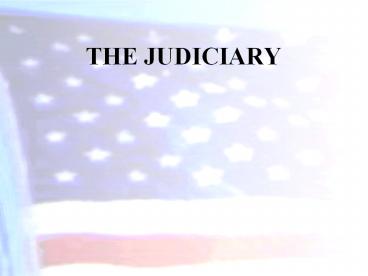THE JUDICIARY PowerPoint PPT Presentation
1 / 19
Title: THE JUDICIARY
1
THE JUDICIARY
2
The Constitution and the National Judiciary
- Article III of the Constitution establishes
- a Supreme Court in which the judicial power of
the United States is vested - life tenure or good behavior for judges
- judges receive compensation that cannot be
diminished during their service - such inferior courts as Congress may choose to
establish - the original jurisdiction of the Supreme Court
- The intent of Article III was to remedy the
failings of the Articles of Confederation which
left judicial matters to the states.
3
Article III - Supreme Court
- President appoints
- Senate confirms
- http//supremecourt.c-span.org/
4
Generally speaking, the Court will hear cases
- involves a basic constitutional principle
- an important question of federal law
- conflict between state and federal laws
5
Presidential Nominations
- The president usually tries to nominate a justice
whose political philosophy is similar to his/her
own - The nominee must win approval of the Senate
- We refer to periods by the Chief Justice (Berger
Court, Warren Court, Rehnquist Court)
6
Political Philosophy
- Court - an ever changing political institution
that fluctuates between liberalism and
conservatism as well as activism and restraint.
7
Judicial Review
- Judicial review is the power of a court to decide
if a law or other legal issue contravenes the
Constitution, and overturn it. - This power is not mentioned in the Constitution.
- Judicial review was established by the Marshall
Court for itself and posterity in Marbury v.
Madison (1803). - Marbury's long-term effect has been to allow the
Court to have the final say in what the
Constitution means.
8
The American Legal System
- The American legal system is a dual system
- state courts--actually 50 different 'systems'
- federal courts HOW A TRIAL WORKS VIDEO
- Both systems have three tiers
- trial courts--litigation begins and courts hear
the facts of the case at hand (original
jurisdiction) - appellate courts--decide questions of law, not
fact (appellate jurisdiction) - high or supreme courts
- HANDOUT FOR THE APPEALS PROCESS
9
Judicial Activism
- The Court should take an active role in using its
powers to check the actions of Congress,
legislatures, the executive branch and agencies.
10
Judicial Restraint
- The Supreme Court should defer to the decisions
made by elected representatives of the people in
the legislative and executive branches.
11
(No Transcript)
12
Federal Selection Process
- The selection of judges is a very political
process. - Judges are nominated by the president and
confirmed by the Senate. - Often presidents solicit suggestions from members
of the House of Representatives, Senators, their
political party, and others. - Provides president opportunity to put
philosophical stamp on federal courts
13
How the Justices Vote
- Legal Factors
- Judicial Philosophy
- Judicial Restraint - advocates minimalist roles
for judges, and the latter - Judicial Activism - feels that judges should use
the law to promote justice, equality, and
personal liberty. - Precedent
- Prior judicial decisions serve as a rule for
settling subsequent cases of a similar nature.
14
How the Justices Vote
- Extra-Legal Factors
- Behavioral Characteristics
- The personal experiences of the justices affect
how they vote. Early poverty, job experience,
friends and relatives all affect how decisions
are made. - Ideology
- Ideological beliefs influence justices' voting
patterns. - The Attitudinal Model
- A justice's attitudes affect voting behavior.
- Public Opinion
- Justices watch TV, read newspapers, and go to the
store like everyone else. They are not insulated
from public opinion and are probably swayed by it
some of the time.
15
(No Transcript)
16
How Supreme Court Decisions are Made
Case on the Docket Approx 95
Briefs and Amicus Briefs submitted
Oral Argument
Justices Conference Cases discussed Votes
taken Opinion Assigned
Opinions Announced
Opinions Drafted and Circulated
17
Landmark Cases
- Marbury vs. Madison (1803) judicial review
- McCulloch vs. Maryland (1819) upheld implied
powers clause - Gibbons vs. Ogden (1824) power to regulate
interstate commerce, federal law prevails over
state law - Dred Scott vs. Sandford (1857) contributed to the
Civil War
18
Landmark Cases cont.
- Plessy vs. Ferguson (1896) separate but equal
- Brown vs. Board of Education (1954) separate is
inherently unequal - Baker vs. Carr (1962) reapportionment, one person
one vote - Roe vs. Wade (1973) right to privacy
19
The Supreme Court Today
- According to a 1990 poll, only 23 of Americans
knew how many justices sit on the Supreme Court,
and two-thirds could not name a single member. - In 1998, a poll of teenagers showed that only 2
could name the Chief Justice. - Yet, Supreme Court decisions have been credited
with strengthening the Constitution, increasing
the power of the federal govt., starting the
Civil War, reshaping race relations, restoring
fairness to our electoral system, redefining the
rights of women, and most recently deciding a
presidential election!

